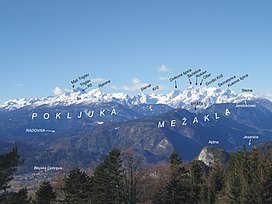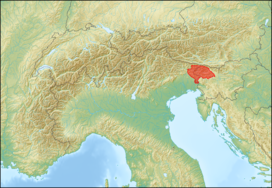|
Julian Alps
The Julian Alps (Slovene: Julijske Alpe, Italian: Alpi Giulie, Venetian: Alpe Jułie, Friulian: Alps Juliis, German: Julische Alpen) are a mountain range of the Southern Limestone Alps that stretch from northeastern Italy to Slovenia, where they rise to 2,864 m at Mount Triglav, the highest peak in Slovenia. A large part of the Julian Alps is included in Triglav National Park. The second highest peak of the range, the 2,755 m high Jôf di Montasio, lies in Italy.[1] The Julian Alps cover an estimated 4,400 km2 (of which 1,542 km2 lies in Italy). They are located between the Sava Valley and Canale Valley. They are divided into the Eastern and Western Julian Alps. NameThe Julian Alps were known in antiquity as Alpes Iuliae, and also attested as Alpes Julianae c. AD 670, Alpis Julia c. 734, and Alpes Iulias in 1090.[2] Like the municipium of Forum Julii (now Cividale del Friuli) at the foot of the mountains, the range was named after Julius Caesar of the gens Julia,[2][3] perhaps due to a road built by Julius Caesar and completed by Augustus.[4] Eastern Julian Alps There are many peaks in the Eastern Julian Alps over 2,000 m high, and they are mainly parts of ridges. The most prominent peaks are visible by their height and size. There are high plateaus on the eastern border, such as Pokljuka, Mežakla, and Jelovica. The main peaks by height are the following:
Western Julian AlpsThe Western Julian Alps cover a much smaller area, and are located mainly in Italy. Only the Kanin group lies in part in Slovenia. The main peaks by height are:
PassesImportant passes of the Julian Alps are:
See also
References
External linksWikimedia Commons has media related to Julian Alps. |
||||||||||||||||||||||

